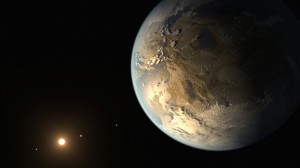
Artist’s conception of a habitable exoplanet in orbit around its red dwarf star. Credit: NASA Ames/SETI Institute/JPL-Caltech. From http://themeridianijournal.com/2014/04/big-discovery-first-earth-sized-exoplanet-habitable-zone-another-star/#more-5509.
Interesting paper from Prof. Michael Jura at UCLA and colleagues, in which they look for the chemical signatures of plate tectonics in white dwarfs that are accreting planetary and asteroidal material. The paper presents a really neat idea, combining several big concepts.
First, there is strong evidence that several white dwarfs (the ghostly remnants of Sun-like stars) are accreting rocky materials. The atmospheres of white dwarfs are very simple, hot hydrogen and helium cooling to space over billions of years. Any other, heavier elements quickly settle out of the atmospheres (on timescales of millions of years), and so if you find such, heavier elements in the atmospheres (via spectroscopy), those elements were probably recently dumped into the atmosphere — a process called pollution.
Such pollution has been observed for many white dwarfs, and the pollution typically consists of rocky elements, silicon, magnesium, etc. Consequently, the polluting materials probably come from rocky asteroids, falling into the white dwarfs. Jura and colleagues point out that some of the pollution may arise from the crusts of extrasolar rocky planets orbiting the white dwarfs, in the form of debris from large impacts with the planetary surfaces.
Second, on the Earth, the constant subduction and eruption of crustal materials from plate tectonics has the effect of sieving out certain elements and leaving them in the crust, producing a crustal composition distinct from that of other planets and asteroids.
Jura and colleagues went looking for such a chemical signature in the rocky pollution of white dwarfs but unfortunately don’t find it. However, this initial study may provide a novel to search for the signs of plate tectonics in other planetary systems. That’s important because plate tectonics is thought to be a key requirement for making a planet suitable for life, but observing it astronomically is almost impossible (there’s no strong evidence any solar system planets other than Earth experienced/s plate tectonics). Jura and colleagues may have provided us a new way to peer into the geophysical histories of extrasolar planets.